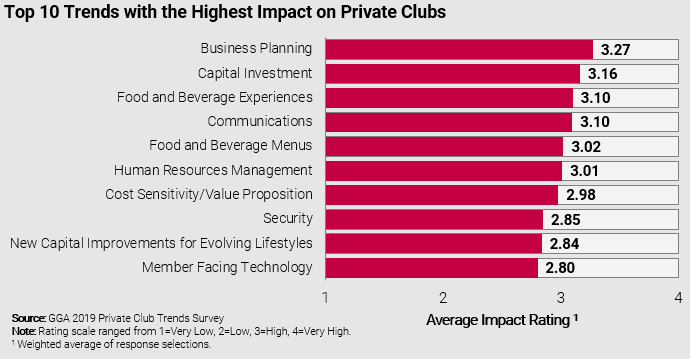Member satisfaction surveys are a rich source of data and intelligence for measuring year-on-year club performance, but fall short of accounting for the changing face of members’ needs and expectations. GGA’s Michael Gregory explains the need for a different type of survey, and the questions you be should be posing to your members.
Why is it that member satisfaction surveys are not an effective mechanism to capture everything that members need, want and expect?
By definition, the primary objective of a member satisfaction survey is exactly that: to measure member satisfaction.
Straying from an accepted format or structure without providing the necessary context may lead to a drop off in engagement levels. So, while you can potentially look to feed in additional questions to source particular information or data from your members, the key is to be relevant.
The advantage of a survey for any given situation is the club’s ability to gauge members’ feelings or attitudes on that specific topic or project. If the board is considering a capital project – a new clubhouse for instance – a dedicated survey would represent an effective way of obtaining some invaluable insights, as well as learning whether members could tolerate increases to dues in order to accommodate this, and support for other methods of funding.
Can members get ‘survey fatigue’? If so, how can you avoid this situation to ensure you capture reliable, insightful data?
Undoubtedly. Times have changed and we have witnessed first-hand how the willingness of members to devote significant time to surveys is decreasing.
Around 10 years ago, it was entirely possible to carry out a combined satisfaction and strategic survey of members which could take up to 45 minutes to complete. With changes to device use and attention span, new tactics have emerged to overcome the possibility of survey fatigue, including:
- Different types of surveys – from shorter, pulse surveys to more immersive, philosophical, and strategic surveys. Providing each is structured to capture the interest and engagement of members, this will mitigate any possibility of an attention ‘drop off’.
- Segmentation – not all surveys will require input from all members. So, providing you involve an appropriate cross section for a given survey, this will ensure you’re not asking too much of too many members all at once.
- Accessibility – by making all options available to your members in terms of how they can complete a survey (cell phone, tablet device, desktop or hard copy), you allow them to make a choice in which way they find most comfortable, convenient and quick.
Finding the right survey approach demonstrates to your membership that their opinion matters, you are open to change, and that the club wishes to maximize its relevance to the majority of members. Crucially, it eliminates the possibility of a reactive ‘culture creep’ where decisions are made on the basis of vocal minority opinion rather than how they should be made – through data-driven decision making.
When’s the optimum time to be running member survey(s)?
This is really determined by the need and seasonality for each club. Some surveys will be linked to time-defined events (such as those focused towards capital projects), so would need to happen within a given window.
If a club is looking at a strategic or attitudinal survey then the timing is somewhat less critical – though the off-season can be a good time to survey members on these topics.
Things are more certain when it comes to surveying members on how satisfied they are. Our research and data in this area points to the period following the peak season as the optimum time to question members about their year-on-year sentiments towards the club, and there are some key reasons for this:
- Members have just experienced the club in its best light – so they are more likely to be engaged, positive, but also practical and pragmatic in their assessment and recommendations.
- A maximum number of members are utilizing the club – with the seasonal nature of a number of clubs, members can often go into hibernation during the off-season. So, surveying these individuals at a time when the club is far from their mind and everyday life is unlikely to provide qualitative data and insights. Conversely, questioning members when the club is a highly relevant part of their day-to-day life will ensure everyone’s voice is heard.
How do you interpret the findings and how (much) should they help to inform wider strategic club intentions?
Asking the right questions is only part of the process. Much of my work involves spending a great deal of time interpreting results by looking at the key drivers and mapping these against various demographic filters; this reveals differences of opinion between various groups such as men and women, newer and longer-tenured members, younger and more senior members, and various other categories. All helping to fuel the right future strategy for the club.
However, this process can be more complex than what it seems.
Take, for example, a case where the food and beverage operation is the lowest rated component of the services, amenities and activities available to members. The natural inclination would be to hone in on this area as one requiring action and improvement. But this is where key drivers come in. What really drives the satisfaction of members? Which areas are they most sensitive to? And therefore, where should your focus lie (not always the lowest-ranked component)?
Once these key drivers are determined they can prompt specific strategic action, or, in cases where more information is needed, spin off surveys. Understanding the key factors that are driving member satisfaction helps to interpret survey results in an aggregate context, one in which outputs on specific questions are considered relative to others in order to help the club prioritize areas of focus and support justifications for doing so.
What have you observed from clubs who do/don’t take a keen interest in finding out more about the needs and wants of their members?
Making operational and strategic decisions based on perception or the opinions of a vocal minority is one of the greatest risks a club can face.
The club that makes it a priority to obtain feedback from its members has a solid understanding of the factors that caused its members to join, an annual measure of current performance relative to expectations, understands the key drivers of satisfaction, and has a clear notion of its members’ hopes and goals for the club.
More than that, by taking an active interest in the opinions of its members, the club takes them on a journey and demonstrates trust, transparency, and the benefits of data driven decision-making along the way.
In cases where the vocal minority come forward with points of dissatisfaction, the robust data at the hands of managers creates a credible sense of authority when engaging in dialogue.
Any final thoughts to add?
In any member survey, communication and transparency are key. Start your process with focus groups – this helps generate buy-in and trust in the process, and also shows you are (literally) willing to listen to the opinions of members.
Once you have embarked on the process, keep members informed about the next stages and the reasons behind conducting a survey. It’s highly likely they will speak with one another about the process and the details of any survey, so regular club communication will ensure there’s no room for misinterpretation or myths arising.
The final, and arguably the most important consideration, is confidentiality. Members should embark on a survey in the knowledge that their individual responses will be securely held by an independent third party. This affords them the opportunity to respond candidly and feel comfortable enough to air out dissenting opinions, frustrations, and constructive criticisms that may bring to light or reinforce issues which otherwise may not be shared.
Crucially, this arms club leaders with the authentic, informative feedback they need to be effective strategists.
This article was authored by GGA Senior Manager and Market Intelligence expert Michael Gregory.








